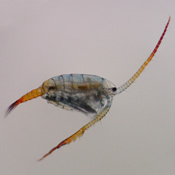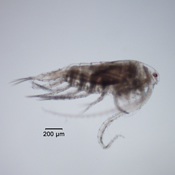| Distinguishing Characteristics | |||||
|
|||||
| Ecology and Behavior | |||||
| Geographic Distribution | |||||
| A. leptopus is a primarily a northern species in North America (2) widely reported from Virginia to Oregon, across the northern continent to Alaska, British Columbia and Alberta, Canada (3), south throughout the Rocky Mountains (1) and Arizona (1)(2). It also occurs in Australia (4). | |||||
| Reported Habitats | |||||
| Because of its large size, A. leptopus is vulnerable to fish predation and therefore is often found in small, temporary ponds, permanent ponds, and small bog lakes, systems that are usually fishless due to drying out or winter kill (1). A. leptopus can tolerate acidic waters that exclude fish (6). When found in fishless lakes, A. leptopus is present throughout the whole season, even under ice cover (1).
In Walker Lake, Arizona, a senescent crater lake, warm epilimnetic waters were preferred by A. leptopus, where there were generally higher concentrations of dissolved oxygen and phytoplankton (5). A. leptopus also inhabites ponds or lakes with a substrate consisting of gravel, mud, sand, moss or a combination of these, but was not found where the substrate was grassy (3). A. leptopus may occur at high altitudes, from 5,300 to 10,900 feet (2), as well as farm ponds much closer to sea level (7). |
|||||
| Food and Feeding Behavior | |||||
| Usually considered an omnivore (6), A. leptopus may prefer feeding on diatoms (5). If conditions allow the phytoplankton to be concentrated in deeper water, A. leptopus will follow the food source to lower depths (5). | |||||
| Reproductive Habits | |||||
| During the low temperatures of early spring, development from a diapause egg to sexual maturity can take 6-8 weeks but at higher temperatures this process can be completed in only 3 weeks (1). Hatching diapause eggs contribute to the population during alternating wet and dry periods when there is not enough time for adults to reproduce (1)(8). Two to three generations of individuals can be produced during the season, depending on the permanency of the water (8). Female A. leptopus undergo regular cycles of egg production that can be easily viewed by changes in the appearance of the reproductive tract. The female reproductive tract, or oviduct, is visible through the transparent exoskeleton and has two phases: dark and clear (7). During the dark phase the oviduct is filled with gametes (7). A. leptopus periodically release unfertilized eggs, thus transitioning into the nongravid, clear phase (7). After a brief period, the oviducts gradually refill with ripe gametes, entering the gravid dark phase. Females that mate during their clear phase do not produce viable clutches while 50% of those mating during the dark phase have successful egg clutches (7). These clear and dark phases do not appear to be synchronized within the population; each female acts independently of the others (7). Numbers of eggs produced may range from approximately 10 to 150 per female per clutch and females can produce new clutches in as little as 1 week (8). The ratio of males to females is highly variable, though the male population usually has the highest numbers of individuals (8). |
|||||
| Predation on Aglaodiaptomus | |||||
| A. leptopus is vulnerable to fish predation because they are large and often inhabit surface waters (1)(5). Additionally, in arctic tundra ponds, A. leptopus is vulnerable to predation by Red Phalaropes, a shore bird that specializes in feeding on zooplankton in shallow surface waters (9). A. leptopus were the main diet of the larval stages of Ambystoma tigrinum (tiger salamander) that also inhabited the top 30 cm of the water column in Walker Lake, Arizona (5). They are also prey to invertebrate predators such as dytiscid beetle larvae (Graphoderus) in a shallow farm pond in New Hampshire (10). | |||||
| Competition | |||||
| A. leptopus is not vulnerable to Chaoborus predation and therefore benefits from the elimination of its competitors by Chaoborus (11). During the day, Chaoborus inhabit the oxygen-poor depths of the water column while A. leptopus prefers the oxygen rich surface waters.
In fishless lakes A. leptopus, Daphnia pulex and Diaphanosoma brachyurum tend to occur in higher abundances(12). Competition for food usually excludes the coexistence of multiple diaptomid species. However, Hesperodiaptomus wilsonae (approximately 1.5 mm male length) and Leptodiaptomus minutus (0.9-1.0 mm male length) can coexist with A. leptopus as size variation reduces competition for resources (2). A. leptopus also co-occurs with other diaptomid species such as the very large Hesperodiaptomus breweri (female 4.19 mm - male 3.71 mm), and the smaller Onychodiaptomus sanguineus (females 1.19-1.73 mm, males 1.04-1.59 mm) and Leptodiaptomus intermedius (female 1.22 mm, male 1.09 mm) (11). Cyclopoids rarely co-occur with A. leptopus (5); yet in a study of western Canadian lakes, six species of cyclopoids were found with A. leptopus (Acanthocyclops robustus, Acanthocyclops vernalis, Ectocyclops phaleratus, Eucyclops agilis, Eucyclops speratus and Marcrocyclops albidus)(3). These co-occurrences appear to be possible because of differences in the size of food eaten, preferred depths and reproductive cycles (13). |
|||||
| References | |||||
|
(1) TORKE, B. 2001. The distribution of calanoid copepods in the plankton of Wisconsin Lakes. Hydrobiologia. 453/454: 351-365. (2) COLE, G.A. 1961. Some Calanoid Copepods from Arizona with notes on congeneric occurrences of Diaptomus Species. Limnol. Oceanogr. 6: 432-442. (3) SHIH, C. AND R. CHENGALATH. 1994. Freshwater littoral copepods of British Columbia and Alberta (Canada). Hydrobiologia. 292/293: 379-388. (4) GEDDES, M.C. AND G.A. COLE. 1981. Variation in sexual size differentiation in North American Diaptomids (Copepoda: Calanoida): Does variation in the degree of dimorphism have ecological significance? Limnol. Oceanogr. 26: 367-374. (5) BLINN, D.W., AND J. GREEN. 1986. A pump sampler study of microdistribution in Walker Lake , Arizona , U.S.A.: a senescent crater lake. Freshwater Biol. 16: 175-185. (6) STEMBERGER, R.S., D.P. LARSEN, AND T.M. KINCAID. 2001. Sensitivity of zooplankton for regional lake monitoring. Can. J. Fish. Aquat. Sci. 58: 2222-2232. (7) WATRAS, C.J. AND J.F. HANEY. 1980. Oxcillations in the reproductive condition of Diaptomus leptopus (Copepoda: Calanoida) and their relation to rates of egg-clutch production. Oecologia. 45: 94-103. (8) SAWCHYN, W.W. AND U.T. HAMMER. 1967. Growth and reproduction of some Diaptomus spp. in Saskatchewan ponds. Can. J. Zool. 46: 511-520. (9) DODSON, S.I., AND D.L. EEGGER. 1980. Selective feeding of Red Phalaropes on zooplankton of artic ponds. Ecology. 61: 755-763. (10) MORALES SOLANO, P. 1977. Preliminary studies of predation by Graphoderus spp. larvae (Insecta:Coleopters) on zooplankton. Master of Science in Zoology Thesis, University of New Hampshire . pp. 42. (11) KELLER, W. AND N.D. YAN. 1998. Biological recovery from lake acidification : Zooplankton communities as a model of patterns and processes. Restoration Ecology. 6: 364-375. (12) KELLER, W. AND M. CONLON. 1994. Crustacean zooplankton communities and lake morphometry in Precambrian Shield Lakes, Can. J. Fish. Aquat. Sci. 51: 2424-2434. (13) HAMMER, U.T. AND W.W. SAWCHYN. 1968. Seasonal succession and congeneric associations of Diaptomus Spp. (Copepoda) in some Saskatchewan ponds. Limnol. Oceanogr. 13: 476-484. |
|||||
| Additional Pictures | |||||
|
|||||
| Quicktime Movies | |||||
|




